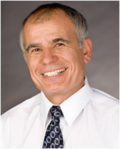
RADLAB Seminar
Reconfigurable Multifunctional Antennas
Add to Google Calendar

The requirements for increased functionality, such as direction finding, radar, control and command, within a confined volume, place a greater burden in today’s transmitting and receiving systems. A solution to this problem is the re-configurable antenna. Antennas that can be used for multiple purposes, that function over several frequency bands and that can be integrated on a package for mass-production are the ultimate goals of commercial and defense investigators. Furthermore, applications of such systems in personal and satellite communications impose the requirement for elements miniaturized in size and weight. Key-elements to obtain reconfigurability in many RF circuits are the Radio-Frequency MicroElectroMechanical Systems (RF-MEMS). Even though RF-MEMS have been used in the past to reconfigure filters, phase-shifters, capacitors and inductors, their integration in an antenna system has been limited as it faces a plethora of issues that need to be resolved. The absence of a reconfigurable RF-MEMS antenna system and the recent advances in fractal – and especially Sierpinski gasket-antennas combined with the availability of series cantilever RF-MEMS switches, sparked the pioneering idea to design a multiple-frequency antenna that will radiate on-demand the same radiation pattern at various frequencies. Such a system was designed and successfully implemented, as the first functional, fully integrated RF-MEMS reconfigurable self-similar antenna. In this talk, several reconfigurable antennas are presented and discussed. The antennas to be presented cover a wide range of designs such as fractal antennas, triangular antennas, dipoles and monopoles with variable sleeves. All these antennas make use of MEMS or PIN switches, or rotating feeds to make them reconfigurable. Some of the challenges that the designer has to face in biasing and integrating these switches with the antenna has are also presented and discussed.
Christos G. Christodoulou received his Ph.D. degree in Electrical Engineering from North Carolina State University in 1985. He served as a faculty member in the University of Central Florida, Orlando, from 1985 to 1998. In 1999, he joined the faculty of the Electrical and Computer Engineering Department of the University of New Mexico, where he served as the Chair of the Department from 1999 to 2005. He is a Fellow member of IEEE and a member of Commission B of USNC/URSI, Eta Kappa Nu and the Electromagnetics Academy. He served as the general Chair of the IEEE Antennas and Propagation Society/URSI 1999 Symposium in Orlando, Florida, as the co-chair of the IEEE 2000 Symposium on Antennas and Propagation for wireless communications, in Waltham, MA, and the co-technical chair for the IEEE Antennas and Propagation Society/URSI 2006 Symposium in Albuquerque. Currently, he is an associate editor for the AWPL, the International Journal of RF and Microwave Computer-aided Engineering, and the IEEE Antennas and Propagation Magazine. He was appointed as an IEEE AP-S Distinguished Lecturer (2007-2009) and elected as the President for the Albuquerque IEEE Section in 2008. He served as a associate editor for the IEEE Transaction on Antennas and Propagation for six years, as a guest editor for a special issue on “Applications of Neural Networks in Electromagnetics”in the Applied Computational Electromagnetics Society (ACES) journal, and as the co-editor of a the IEEE Antennas and Propagation Special issue on “Synthesis and Optimization Techniques in Electromagnetics and Antenna System Design”(M arch 2007). He has published about 300 papers in journals and conferences, has 12 book chapters and has co-authored 4 books. His research interests are in the areas of modeling of electromagnetic systems, reconfigurable systems, machine learning applications in electromagnetics, and smart RF/photonic antennas.
 MENU
MENU 
